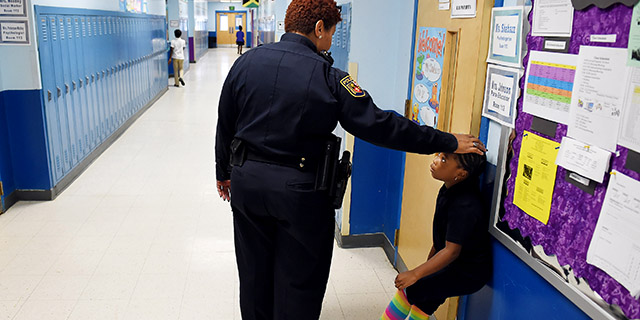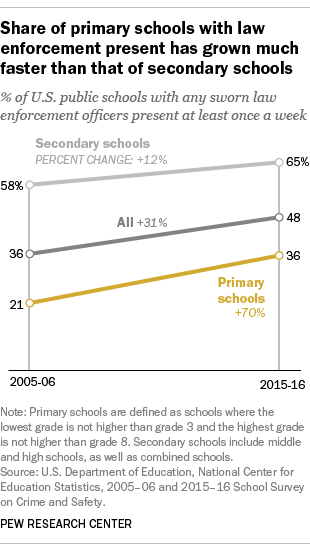
Note: For the most recent data on this topic, read our 2022 post.
A growing share of public primary schools in the United States have sworn law enforcement officers on site, according to a recent government report that comes amid renewed attention to school security.

An estimated 36% of U.S. public primary schools had sworn officers on site at least once a week in the 2015-16 school year, up from 21% a decade earlier, according to the report from the National Center for Education Statistics and the Bureau of Justice Statistics. The share of primary schools with an officer present grew much faster during this period than the share of secondary schools with an officer on site, which increased from 58% to 65%. (The most recent available data for both types of schools are for the 2015-16 school year. Primary schools are defined as schools where the lowest grade is not higher than grade three and the highest grade is not higher than grade eight. Secondary schools include middle and high schools, as well as combined schools.)
The presence of officers at primary schools differed by the size of the school: A quarter of schools with fewer than 300 students reported officers on site, compared with 42% of schools with 500 to 999 students. (Comparable data for primary schools with 1,000 or more students are unavailable.)
Few primary schools with officers on site at least once a week reported that officers were at school for all instructional hours every day (13%). In contrast, 85% of primary schools with officers present said these officers were on site at some point during school hours, while smaller majorities said officers were at school when students were arriving or leaving (67%) or at selected school activities, such as science fairs or athletic events (60%).

While only 36% of U.S. primary schools had officers on site, the vast majority of those schools (86%) reported that officers routinely carried a firearm. (By comparison, 93% of secondary schools with officers present said officers carried a firearm.) Primary schools in cities were less likely than those in towns and rural areas to report that officers carried a firearm. Across all community types, 32% of primary schools with officers present reported having formalized policies or written documents specifically about officers’ use of firearms.
The recent study also found that most primary schools report being prepared for certain crisis scenarios. The vast majority of primary schools overall (91%) had written procedures to be followed in a shooting scenario, up from 76% in 2003-04. Similarly large majorities of primary schools had written procedures for bomb threats or incidents (93%) and natural disasters (96%). Furthermore, large majorities of primary schools conducted lockdown (96%), evacuation (91%) and shelter-in-place (75%) drills during the school year.
Regarding general school safety, majorities of primary schools offered training to classroom teachers or aides in safety procedures (93%) and crisis prevention and intervention (72%), according to the report.



